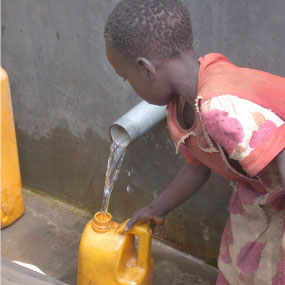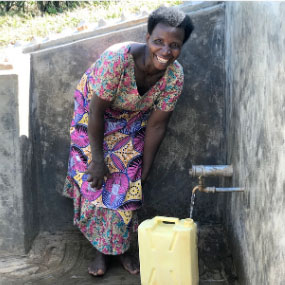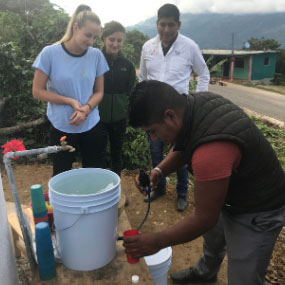Have you ever wondered how we decide what type of water project to build in which country?
Why do we typically dig wells in Northern Uganda, but build rainwater harvesting tanks in Mexico?
There are many factors that determine the cost, location, and type of water source we construct. Some of these factors include in which country the project is being constructed (and what materials are available in their local markets), the landscape of the project site (is it possible to get a drilling rig there?), the geology (whether there is a lot of bedrock), and whether there are any latrines or rubbish piles located close to the proposed project site (any contamination site should be located at least 30 feet away). Here, we break down each type of water source, and why we use (or don’t use) them in certain locations.
DEEP WELLS
What is a Deep Well?
Deep wells (also known as boreholes) access groundwater reserves, known as “aquifers,” which are collections of water deep in the ground, and bring this clean water to the surface through piping and a pump.
They are over 30 metres deep, and typically reach 60-100 metres in Uganda and Ghana.
- Because the water is not exposed to sunshine, water from a deep well will not develop algae or bacterial growth.
The surface water that refills these groundwater reserves (such as rainwater) passes through a natural filtration system on its way down, consisting of layers of soil, sand, and gravel or rocks, making it clean.
- But, just in case debris gets into the well, our partners install multiple screens in the piping of the well, to filter it further.
The water from deep wells must pass a water quality test, and the results must fit World Health Organization and country guidelines before it is considered safe to drink.
Why and Where Do We Build Deep Wells?
Construction of deep wells requires a large, flat terrain, so that a drilling rig is able to make it to the area.
- This is why we don’t build deep wells in areas that are too mountainous, like Western Uganda.
The well must be at least 10 metres away from any contamination site (such as a latrine or garbage pile), and the water source cannot be downhill from a contamination site.
- This ensures that the community’s water source is not contaminated with food or human waste.
Why Don’t We Build Shallow Wells Anymore?
Shallow wells (wells under 30 metres in depth) have actually been phased out by local governments in the countries which we work, as they are no longer considered an effective solution to combat the global water crisis. Climate change has rendered the water from shallow wells less reliable.



PROTECTED SPRINGS
What is a Protected Spring?
Protected springs collect water from existing streams or springs flowing downhill using PVC piping, which then directs the water through a natural filtration system, consisting of rocks, gravel, and sand.
- This filtered water is collected in a cement storage tank and accessed by the community using a tap.
While this water will still need to be boiled and/or filtered through a cloth in order to be safe, it eliminates the numerous threats from stagnant, sun-exposed water, such as bacteria, algae, and insects.
Protected springs also have a manhole cover for the caretaker to enter and clean the cement storage tank every 4-6 months.
Why and Where Do We Build Protected Springs?
We build protected springs in areas which are hard to reach with well drilling equipment, as they may be very mountainous, such as Western Uganda.
- Because it’s difficult for vehicles to reach these locations, protected springs are 100% built by hand!



RAINWATER HARVESTING TANKS
What is a Rainwater Harvesting Tank?
Rainwater harvesting tanks collect rainwater from the roofs of nearby homes, churches, or schools, using PVC piping as gutters, and directs the water to big cement holding tanks, which can then be accessed by the community with a tap.
They have cleaning valves and a square manhole with a cover at the top of the tank, which allows the caretaker to go inside and clean the tank every two months.
The rainwater is collected before it touches the ground, so it is cleaner than surface water from contaminated ponds or hand-dug wells.
- Nevertheless, we advise communities to boil and filter the water before drinking it.
Why and Where Do We Build Rainwater Harvesting Tanks?
Because of the climate of these regions, rainwater harvesting tanks work very well in Central America and parts of Africa, like Malawi.
Rainwater harvesting tanks are extremely effective in remote locations, since they only require a truck to deliver the materials.
There are a few criteria for the communities in which we build rainwater harvesting tanks. They must have:
- A wet or rainy season for three to four months of the year (or have consistent rainfall throughout the year).
- Aluminum or tin roofs somewhere in the community to catch the rainfall.



DONATE TODAY



